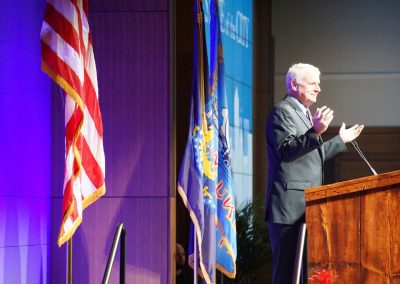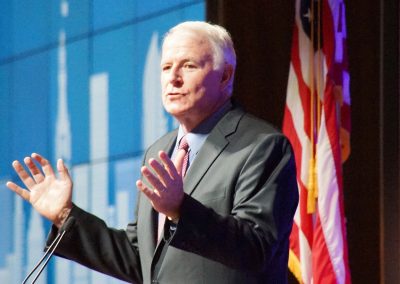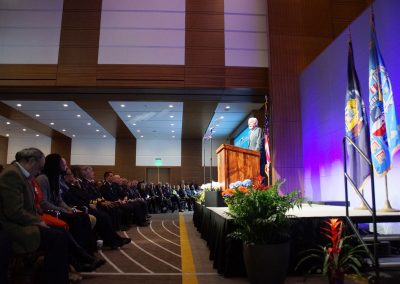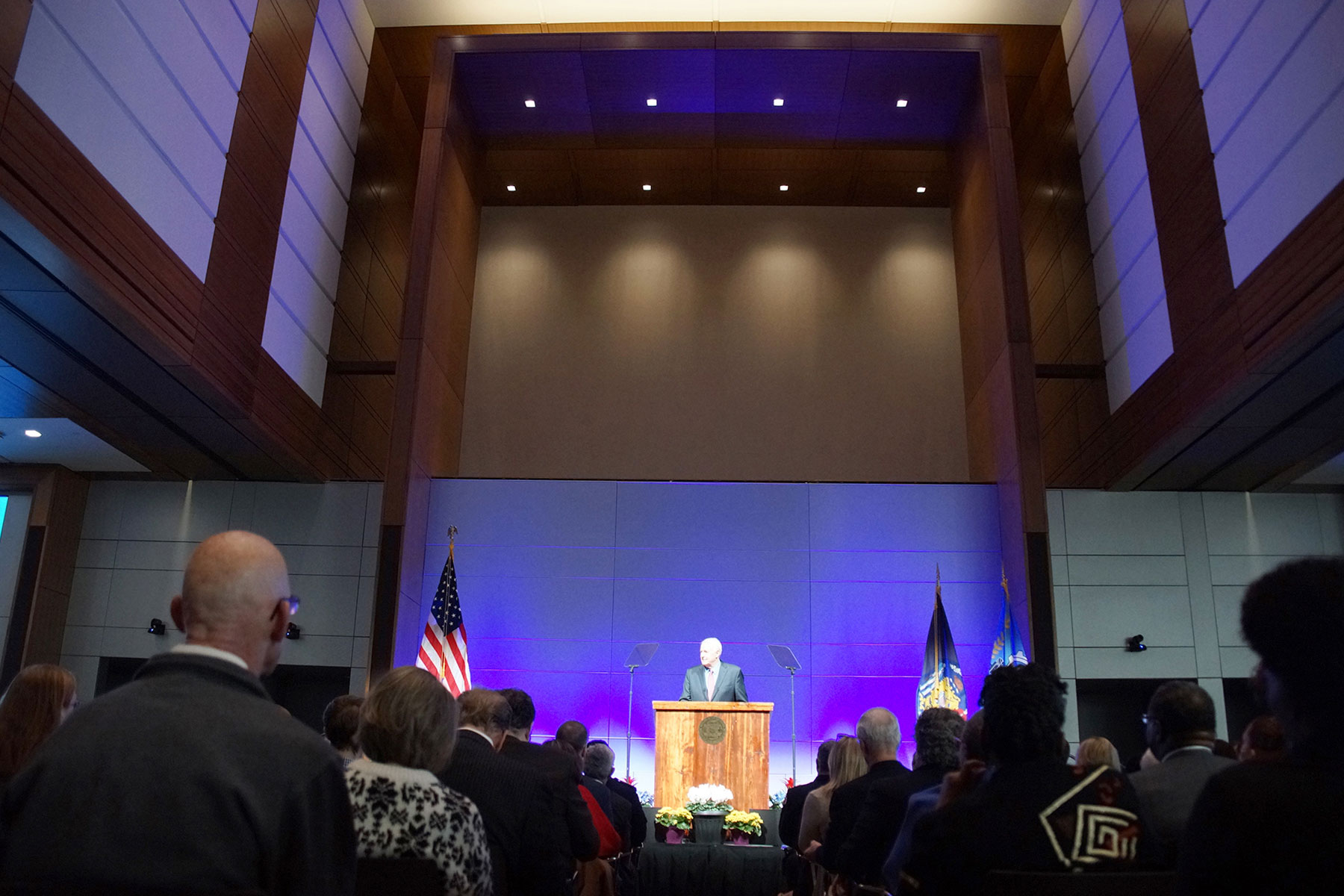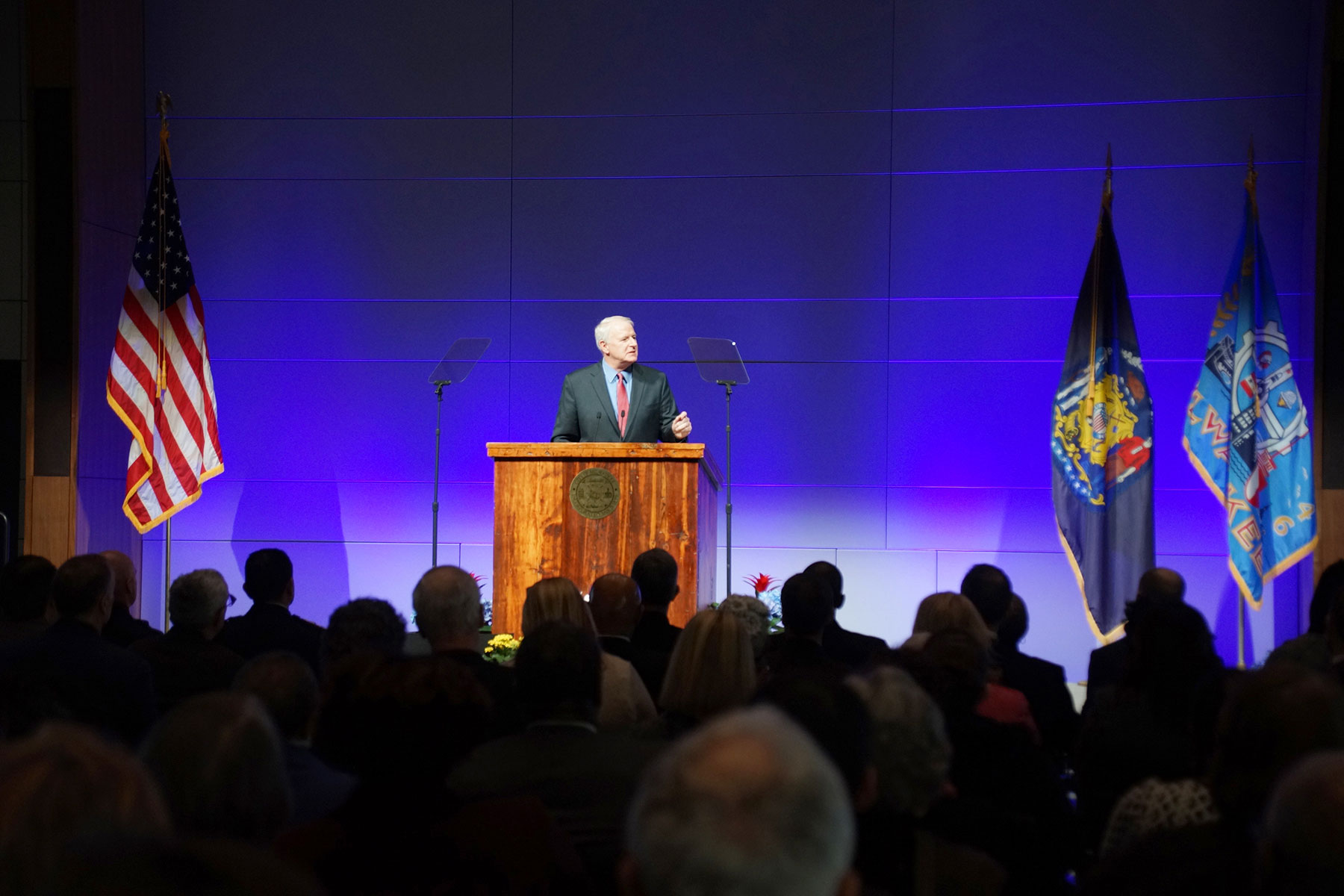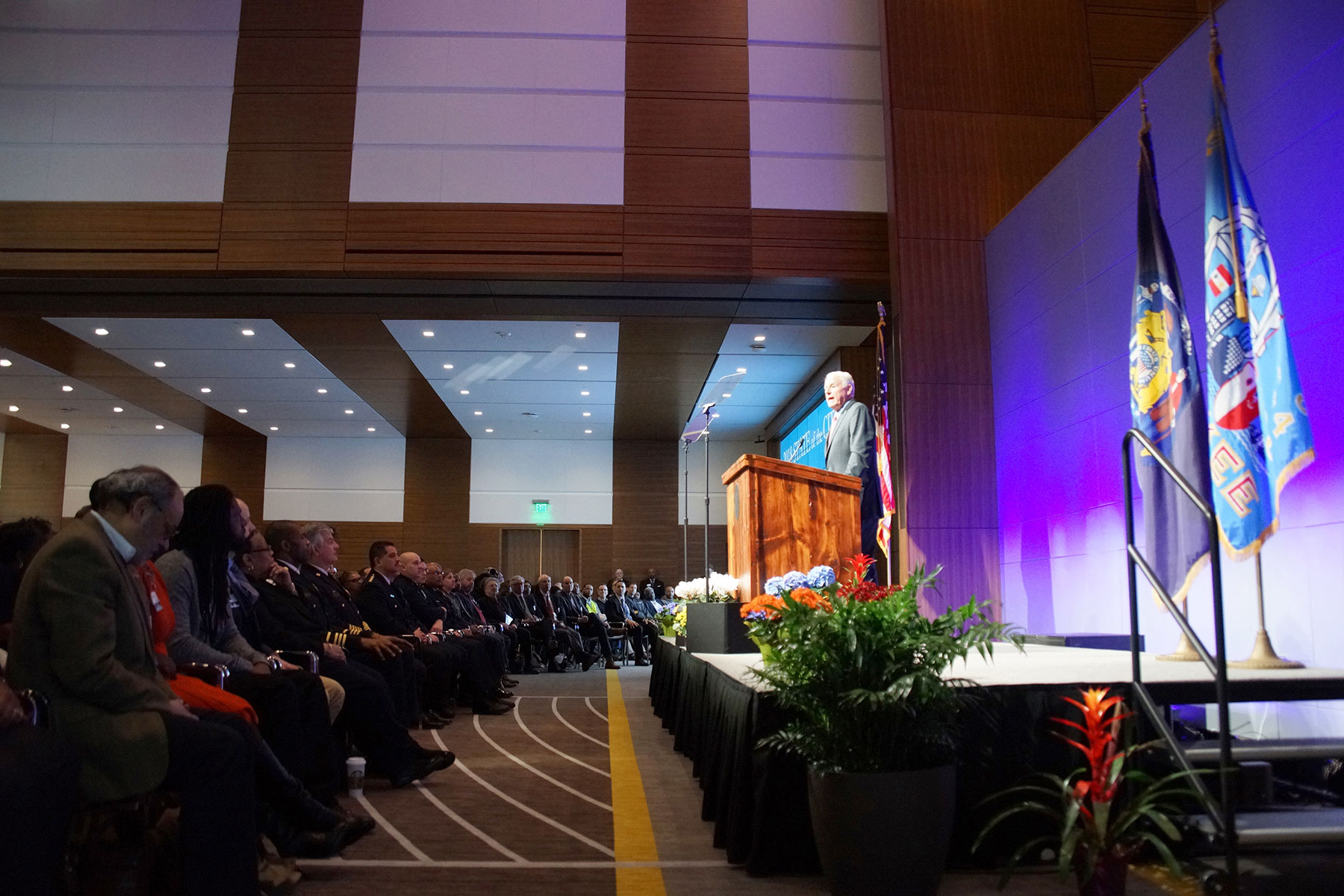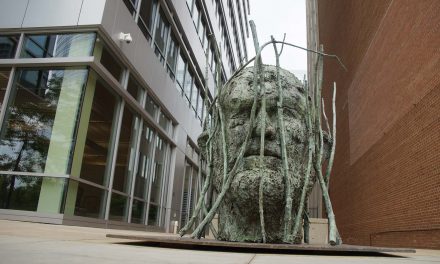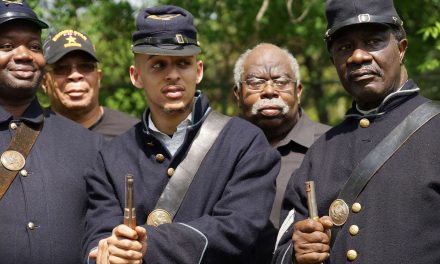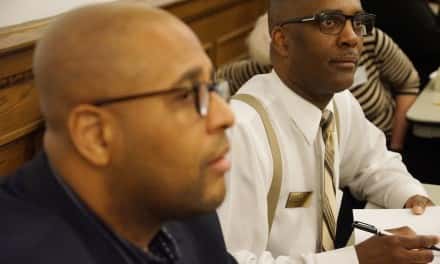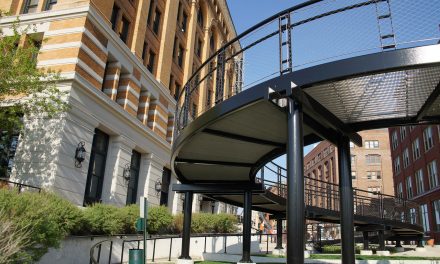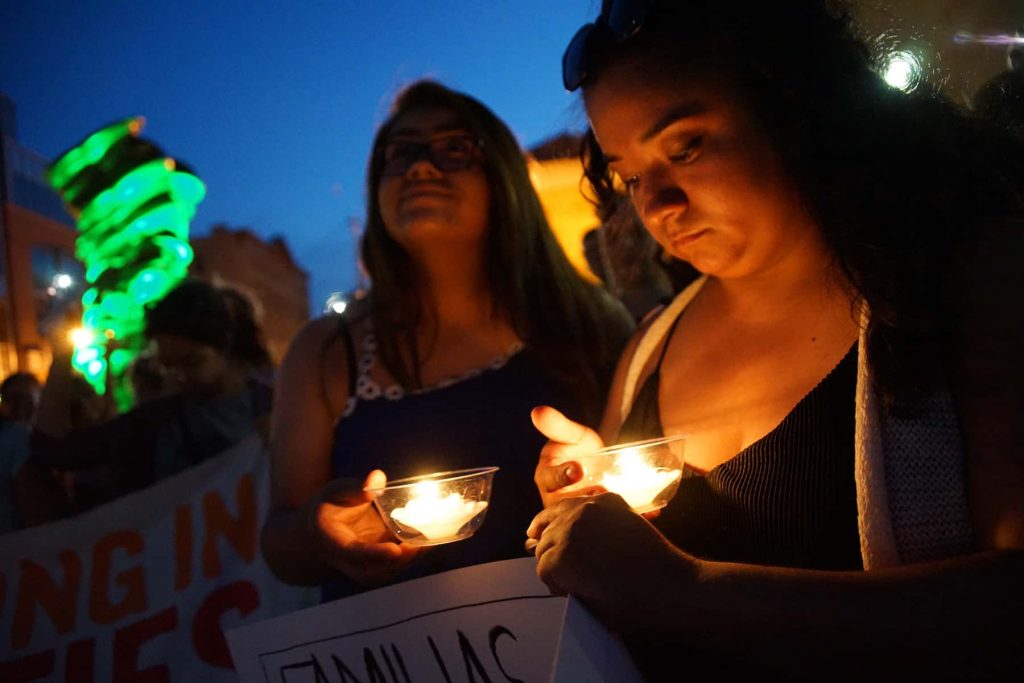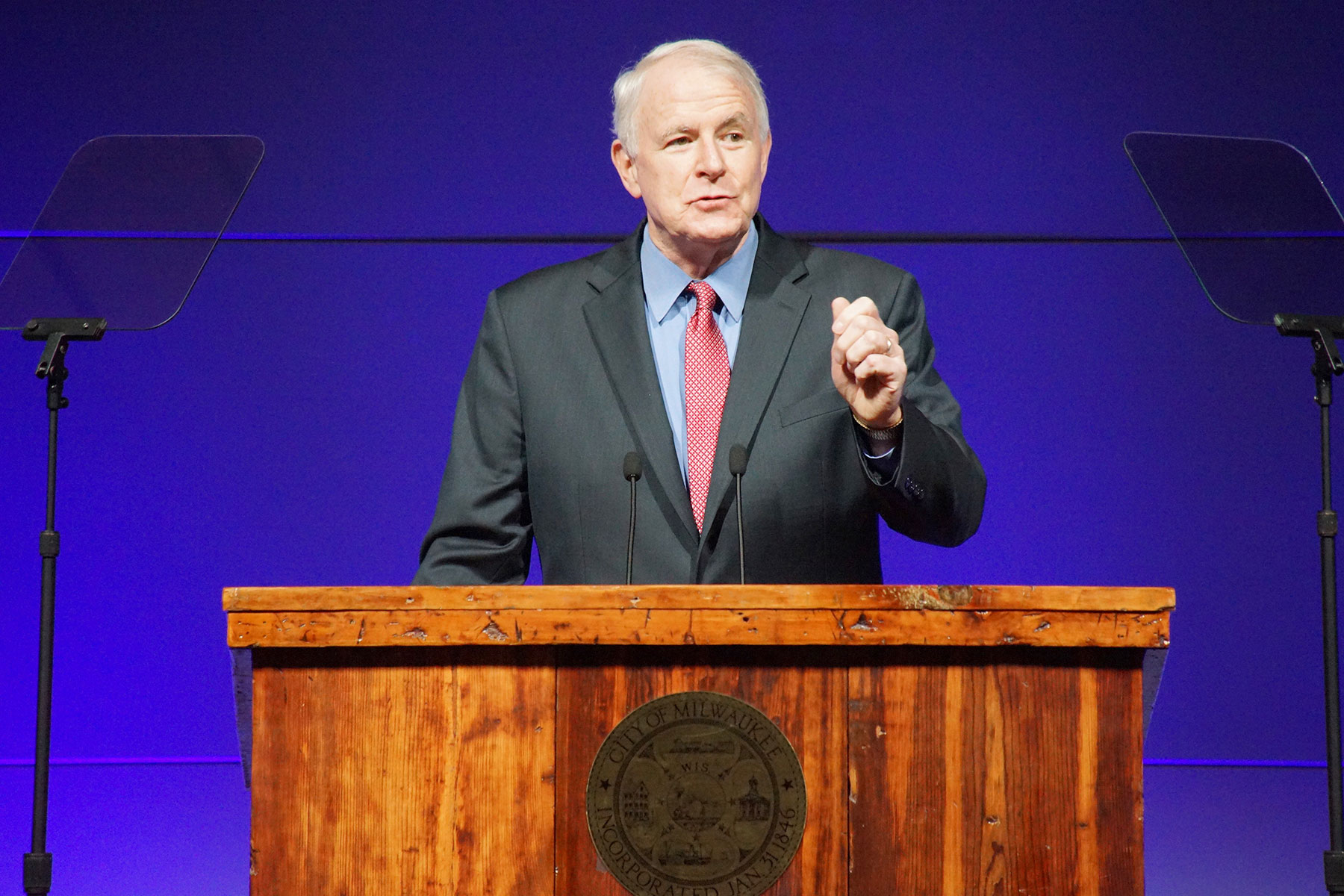
It is a great honor to be here in this breathtaking building and to publicly recognize your commitment to Milwaukee.
I’ll never forget that meeting in your office when you told me you were choosing this location and that you wanted to make a statement that Northwestern Mutual is connected and invested in our city and our future.
You have reshaped Milwaukee’s skyline and you have changed hundreds of people’s lives for the better, connecting Milwaukee workers with career opportunities in the building trades and the insurance industry. Northwestern Mutual met and exceeded all workforce requirements on this building. Let me share their report card with you. It’s really something to be proud of.
Local small businesses were awarded $127 million in contracts, almost a third of the applicable contracts for this building. That’s well above the City’s requirement. Milwaukee residents worked 43% of the construction hours. This too is well above the City’s requirement.
The nearly 800 city residents who were employed here live in all parts of Milwaukee. And, they earned prevailing wages for all their work, including fabricating the exterior glass panels. And those panels were manufactured right at Milwaukee’s Century City.
John, you have accomplished something remarkable. You have given hundreds of residents the opportunity to literally build our City’s future. Now that deserves a round of applause!
But there’s more. John has been the business leader most critical to our educational effort, Milwaukee Succeeds. I know Superintendent Darienne Driver joins me in thanking you for improving education in our community as well.
And what about the incredible Milwaukee Police Band under the leadership of retired Lt. Karen Dubis. Let’s give them a round of applause as well. If you haven’t seen them in the community, you should. They do a great job.
We in Milwaukee are in the midst of a remarkable era. Milwaukee is changing, positively and permanently, as buildings rise and opportunities grow.
Years from now, Milwaukee residents will look back at this time as a pivotal moment in which we established who we are and built the foundation for our future. Jobs are growing in industries that will thrive in the coming decades. We enjoy a quality of life here in which arts, entertainment, and athletics exist at the highest levels.
We have a wealth of community anchors including churches, schools, and neighborhood organizations that serve the common good. And thoughtful people are making investments in our neighborhoods.
For visitors and residents alike, the dramatic transformation of our downtown is easy to see. But, many may not recognize our work in the neighborhoods. Last year, we established four tax incremental districts all outside of the central business area.
On the northwest side, we helped businesses invest at Park Place; at 7th and National Avenue, we advanced a new residential development; at Burleigh Street and Fond du Lac Avenue, we joined investors restoring vitality to a fire damaged building; and at 15th and North Avenue a former ice cream factory conversion will create new apartments.
In the coming year, we anticipate more projects like these. Prudent city investments can assist in bringing development to locations the private sector has overlooked in recent years.
When the global housing bubble burst almost a decade ago, Milwaukee’s role as a property owner and a landlord grew enormously. Tax foreclosed properties became a financial burden for City government, a challenge for neighborhoods, and a disruption for families who needed a place to live.
That’s why I have put so much effort into returning foreclosed properties to private ownership. Last year our real estate team sold 429 houses and commercial buildings – adding new homeowners and quality rental opportunities. The properties we have sold have returned more than $100 million to the city’s tax base since the foreclosure crisis began.
I’m very proud of the progress we are making to improve the lives of Milwaukee residents and the health of our neighborhoods. But there’s much more to be done. So today, I am issuing a challenge – let’s work together to improve housing opportunities for 10,000 Milwaukee households.
I am ready to commit significant tax incremental financing to incentivize the creation of thousands of affordable housing units over the next decade.
While those units can be located anywhere in Milwaukee, I’m especially interested in seeing more affordable housing in the heart of the city. Growing affordable units in these areas will make it easier for workers to get to nearby jobs. Additional development will also create construction jobs for city residents.
As rents continue to be a challenge, home ownership can be a smart financial decision for low- and moderate-income families. So, we will create new paths to home ownership. And we will improve housing opportunities by helping families make the repairs they need to preserve their homes.
I’m happy to announce that Associated Bank is our first corporate partner in this effort. Associated Bank has agreed to purchase a significant portion of our STRONG HOMES Loan portfolio, which means we hope to add approximately $1.5 million to the funds available to help people stay in their homes.
This is a great deal for the City, and for Milwaukee homeowners in need of emergency and essential home repairs. We appreciate Associated Bank’s shared commitment to creating and sustaining homeownership in Milwaukee’s neighborhoods. Associated Bank representatives Nina Johnson, Tom Faughnan, and LaDonna Reed are with us here this morning. Thank you all for your help.
Our “10,000 households” campaign is going to need additional partners. We’re hoping to leverage our city programs with other financial support to keep families in their homes and to create new homes. That’s why I’ll also ask the Wisconsin Housing and Economic Development Authority and lending institutions to increase their investments in affordable housing.
And, we’ll need the commitment of the federal government as well. As Matthew Desmond points out in his powerful book, Evicted, federal housing vouchers are the best way to provide decent housing to very low-income families. That’s why Washington needs to play its part by recognizing the importance of quality housing to families, neighborhoods, and the entire city.
Our Housing Authority is continuing the transformation of Westlawn from an outdated public housing development into Westlawn Gardens, a sustainable, mixed-income neighborhood. Part of this effort included relocating the residents. I’m pleased to let you know seven residents used relocation as their opportunity to purchase their own home.
Alysia Mullins is one of those residents. She moved into Westlawn after overcoming drug addiction and interactions with the criminal justice system.
She used a Housing Authority scholarship to go to college. She’s taken financial literacy classes, saved money and attended the Housing Authority’s homeownership program. Last spring, she earned her Associate’s Degree in Human Services, and a short time later, purchased her very first home. Please join me in offering congratulations to Alysia.
We’ve brought a similar commitment to housing and jobs in Sherman Park. Working with the State, we provide incentives to our partners with two goals – providing jobs for people facing employment challenges, and improving housing and neighborhoods in the greater Sherman Park area.
We are on track to meet our goal of 100 renovated homes. So far, our partners have acquired 75 homes and work is completed or underway at 25 properties. Let me be clear; this is not merely about buildings. It is about people – the people who live in these homes and the seven construction workers from Gorman and Company here this morning. Gorman is partnering with Northcott Neighborhood House to restore homes while also providing valuable job training opportunities.
Please stand and accept our thanks for building our city.
When I talk about our neighborhood investments, I love to talk about libraries. Just months ago, the City opened the doors to our newest branch library, a remarkable, mixed-use development in the heart of the Mitchell Street business area. Mitchell Street is our largest branch library and the most technologically advanced one to date, complete with a makerspace that houses a recording studio and digital editing bays.
Our Milwaukee Public Libraries are anchor institutions in our neighborhoods. They are so much more than places to check out books and DVDs. They are truly inspiring places that promote imagination and information, and help people read, learn and connect to one another.
Next in our branch redevelopment plan is a replacement for the Mill Road library on the city’s far northwest side. Breaking ground later this spring, this new library will bring the latest innovations to another neighborhood, just as we did before with Tippecanoe, East and Villard.
Soon we will have a new neighborhood anchor on the near south side. Earlier this month, I approved a zoning change allowing Cristo Rey High School to expand in the Clarke Square neighborhood.
Students at Cristo Rey combine classroom work with outside employment so that they learn professional skills and build solid connections with local companies. The school will move its campus – and growing student body – to 18th and National Avenue bringing its successful model from West Milwaukee into our City. Thank you Cristo Rey President Andrew Stith for all you do for your students.
We have made significant progress in building a shared and more inclusive vision for Milwaukee’s greater downtown. Through the work of Milwaukee United, we have developed a vision of how the growth and progress we’re seeing in the downtown – the heart of our city – can spread to the adjacent neighborhoods and beyond. We’re designing a 10-year strategic action plan focusing on jobs, housing, demographics and transit.
Dozens of people have come together to identify early action items. There has been consensus about supporting catalytic community-based projects in neighborhoods adjacent to downtown. The work of Milwaukee United will help to ensure that all residents have the opportunity to share in the renaissance of our city.
I’ve had many visitors tell me how impressed they are with the transformation of the heart of our city. It’s true, companies like Bader Rutter, Hammes Company, Foxconn and BMO, just to name a few, have moved or are growing downtown.
I want to thank each and every one of you for investing and believing in Milwaukee. Thank you Jeff Young from Bader Rutter, Jud Snyder from BMO, Robert Chou from Foxconn, and Gary Zwirlein from Hammes Company. Let’s give these individuals and companies an enthusiastic Milwaukee round of applause.
This summer we’ll see the opening of the new Bucks arena. And, within a month, the first streetcar vehicle will arrive in Milwaukee and as anyone who comes downtown can see, we’re making great progress in installing tracks and building streetcar stops. The Hop, presented by Potawatomi Hotel & Casino, is what we’re calling our streetcar and if you haven’t heard already, passengers will ride free for the first year.
Thank you to Potawatomi Hotel & Casino CEO and General Manager Rodney Ferguson for your generous support and thank you for the continued support from the Forest County Potawatomi.
When we were first deciding to build a streetcar I travelled to Portland where they told me it will be controversial until it’s built, and they were right. But they also told me that once it’s built, everyone will start asking when it will come to their neighborhood and that’s what’s happening here.
We’re thinking about the future of the streetcar and how it can be extended to Milwaukee neighborhoods. As part of that, we are engaging residents and business owners in the King Drive, Bronzeville, Harbor District and Walker’s Point neighborhoods to develop a shared vision of what the streetcar can bring.
Of course it offers transportation connections, but it will also bring commercial and residential development. Hundreds of residents have already participated in this process to move Milwaukee forward through transit-oriented development and we look forward to continuing this effort.
In the coming weeks we will celebrate a remarkable, international accolade. I’m proud to say Milwaukee’s RiverWalk has won the 2017-2018 Global Award of Excellence from the Urban Land Institute.
It is an honor decades in the making – the RiverWalk was established as a public-private partnership in the 1980’s. We have steadily increased our investment. In fact, 80% of the City’s investment has taken place since I became Mayor and it has catalyzed almost one billion dollars in increased property values nearby.
The RiverWalk has succeeded in bringing people to the Milwaukee River. Now, we want to replicate that success with RiverWalks along the Menomonee and Kinnickinnic Rivers, and plans are advancing to do just that.
Early next month is an important time in the environmental history of the Milwaukee River. That’s when the demolition of the Estabrook Dam begins.
Elimination of the waterway obstruction will improve water quality, positively affect fish and wildlife habitats, and reduce the potential for flooding. The grant-funded removal will save tax dollars as well, because repairing the aging dam would have cost millions.
The City brought the key players together to get this important project underway. Thank you to MMSD and the County for sharing our commitment to improving our river.
Investing in our young people and our workforce is key to Milwaukee’s future.
I talked a lot about my Earn & Learn program last year and the importance of a first job. Since that time more than 2,800 kids have had that first job experience bringing the total to more than 31,000. Last year we raised over $700,000 to put teens to work. I added crucial “All Stars” to make the team better, and they really came through in winning style.
Please give it up for Harris Turer of the Milwaukee Admirals, Wes Edens and Peter Feigin of the Milwaukee Bucks, Mark Attanassio, Rick Schlesinger and Cecilia Gore of the Milwaukee Brewers and Mark Murphy and Aaron Hart of the Green Bay Packers. Join me in thanking them and all the companies and individuals who support Earn & Learn.
We have partnered with Superintendent Darienne Driver, the Milwaukee Public Schools and the Milwaukee Bucks to launch Mentor Greater Milwaukee. Our goal is to bring mentors into our schools and connect students with adults who will commit to improving academic achievement, attendance and goal setting.
We’re going to need lots of help from individuals, businesses, community groups and churches to achieve success. Please, if you want to make a difference in the lives of Milwaukee’s children, learn more about this opportunity and sign up. This is an effort we should all rally around.
I’ve also been happy to support the creation of the new Office of Early Childhood Initiatives, which will be located within the Milwaukee Public Library. This office will coordinate and increase access to quality services and programs available to Milwaukee parents, ensuring that their young children get an equal start in life and are prepared to enter kindergarten ready to learn.
On the employment front, our Compete Milwaukee jobs program has provided employment for more than 275 City residents. It provides a pay check and training, and it gets results. Most of the Compete alumni have gained unsubsidized employment.
This year, dozens of unemployed City residents will acquire marketable work skills and benefit from specialized job counseling through Compete Milwaukee. Our goal is to launch people like Antwain Childs into family supporting jobs upon completion of the program. Antwain was a 2016 participant in the program and is now employed full-time in the Department of Public Works. Please join me in congratulating Antwain.
This year I’m giving out a special “Lazarus Rising from the Dead” award and here it is…The City of Milwaukee entered into a historic partnership last year – an intergovernmental agreement on a scale that’s unprecedented for this region – to supply drinking water to residents of the City of Waukesha.
For a long time, the prospect of reaching an agreement looked bleak. And, I mean bleak. I insisted the proposed service area meet the requirements of the Great Lakes Compact, and the state said no. But when other Great Lakes Governors saw the plan, they demanded strict compliance with the Compact. So, like Lazarus rising from the dead, the opportunity for cooperation reopened.
This agreement proves that regional cooperation and a genuine commitment to the Great Lakes are not mutually exclusive.
The City of Milwaukee will provide water to Waukesha, increasing waterworks revenue.
Waukesha water customers will save tens of millions of dollars, and they will receive good, fresh drinking water to resolve their radium concerns. Milwaukee benefits; Waukesha benefits; and over the next forty years, residents in both cities will be better off.
Now, part of the deal is a payment to Milwaukee of $2.5 million for infrastructure improvements. Let me tell you why that money is important to me. I plan to designate those funds for a critical health and water utility purpose – to replace lead laterals.
While other communities are not addressing this problem, Milwaukee has been recognized as one of only 21 cities nationwide that has taken steps to address lead service lines.
Our effort has been highlighted nationally as a best practice by organizations such as the Environmental Defense Fund and Pew Charitable Trusts. Along with my concern about lead laterals, I’m also very aware that the greatest lead threat to our children stems from the insidious presence of old lead paint.
In the United States, half a million children each year are considered lead poisoned, 3,000 of those right here in Milwaukee. Our lead rates are too high, and that’s why I have been focused on reducing those numbers since before I became Mayor.
Since 2003, the number of children with elevated blood levels of 10 micrograms or more is down by 90%. And the number of children with blood lead levels of five micrograms is down by 70%.
But it’s not time to stop. We need to focus on getting kids tested and eliminating the hazards they face. We have continued to take decisive action to address deficiencies in our Health Department’s lead program. I have assembled a management team to assist Health Department Interim Commissioner Patricia McManus. It’s great to have you here today, Commissioner McManus.
When it comes to the health and well-being of our youngest residents, we are developing innovative collaborations to help us address the challenges they face.
This past year, we have pushed forward with our citywide Strong Baby campaign sharing positive tips to improve birth outcomes and support prematurity prevention.
While our ad campaigns are informational and thought-provoking – and thank you to Serve Marketing for creating them – my favorite part of this campaign is getting the chance to meet these strong babies in person.
This morning we are joined by Boston, our June Strong Baby, who is with his mom Tiffonique and our October Strong Baby, Natalie, who is with her dad Andrew.
We all care deeply about our children and we want to do all we can to protect them.
Unfortunately, there are too many children in Milwaukee exposed to crime and violence. They are victims and witnesses to trauma. What they experience affects their physical and mental health. It affects their performance in school, their interactions with their peers and may ultimately affect their behavior as adults. The physical wounds are visible, but we also need to tend to their mental health.
That’s why we launched the Trauma Response Initiative in partnership with Milwaukee County and the Milwaukee Police Department to support children and families exposed to battery and domestic violence. We started in Police District 7 and last year expanded to Police District 5.
This initiative expands trauma informed care to families all across our city through a new partnership with the Milwaukee Fire Department. This is the first time this approach has been deployed department-wide in the country. Chief Mark Rohlfing and Assistant Chief Gerard Washington, thank you for your leadership.
One of the shared principles of our public health approach to violence is that the effects of violence are preventable – not inevitable. We can and must make a difference.
With the recent launch of the Blueprint for Peace, we continue to advance violence prevention. We’ve invested half-a-million dollars in community-driven solutions. Together, we will build a safer city.
This city’s violence prevention efforts coincide with two consecutive years of homicide reduction. I am committed to seeing this decline continue.
That’s why this year we are investing $280,000 in Ceasefire Milwaukee to reduce the cycle of retaliatory violence that drives many of the shootings in our city. This effort is generously supported by Google, Bader Philanthropies, Live Free, and the Greater Milwaukee Foundation.
I am also pleased to announce that our Office of Violence Prevention will be strengthening its support of Beyond the Bell Milwaukee, an effort to ensure that young people in our community have access to quality programs and services during critical out-of-school hours.
I want all of you to know that I stand with the students from Florida’s Marjory Stoneman Douglas High School. We need action at the federal and state level to reduce gun violence. It is beyond disturbing that those in power fail to address the need for background checks. Let me remind you about a local shooting that highlights the hypocrisy.
On October 21, 2012, a mass shooting occurred at the Azana Salon & Spa in Brookfield. Zina Daniel had a restraining order issued by a court against her husband, meaning under federal law he was prohibited from buying a gun from a licensed dealer. That did not stop him.
He did what millions of Americans do every day: he went to the internet. But he went to the internet because a gigantic loophole exists allowing people to buy guns through the internet without any background check – no background checks even for people with a history of domestic violence, restraining orders, or serious mental health issues.
Specifically, he found the ARMSLIST-dot com website. ARMSLIST brokers gun sales between buyers and sellers. No background checks required. Then, the day before the shooting, the killer picked up a 40-caliber pistol and three magazines. The next day, he shot and killed Zina, Cary Robuck and Maelyn Lind. He then turned the gun on himself.
Just shy of three months later, we mourned the 20 children and 6 adults killed at Sandy Hook Elementary Scholl. And the list goes on: San Bernardino, Orlando, Oak Creek, the Dallas police shootings, Las Vegas, and of course Marjory Stoneman Douglas High School.
After yet another mass shooting, when someone dismissively says “now is not the time for knee-jerk reactions,” I am angered.
I am angered that the NRA, our President and those afraid of losing NRA money want teachers to carry loaded firearms in classrooms. Talk about a kneejerk reaction.
But let me bring it home. Last year, Milwaukee had 119 homicides and 558 non-fatal shootings. Our police are doing a great job of taking guns off the street. Last year alone, they recovered 2759 guns.
That’s why I cannot and will not minimize the devastating impacts of gun violence. Our Milwaukee Police Department and our multiple community and faith-based partners are working day and night to prevent and deter gun violence.
We can all agree that prevention and policing are necessary to address the issue. But, from where I stand, universal background checks – including mandatory background checks on all internet related firearm sales, a ban on assault weapons and a full-fledged effort by the State and Federal governments to tackle the illegal gun trade are necessary components as well.
In the last few years, police community relations have been on the front burner across the United States. For over 100 years, Milwaukee’s Fire and Police Commission has done what many cities are just now trying out: to establish clear and accountable civilian oversight of our Police and Fire Departments.
The Commission has been the place for residents to express expectations of their police and fire services. The Commission also offers a fair and transparent process to address and resolve issues. Recently, Commission members developed and implemented the Milwaukee police chief selection process.
Interim Police Chief Al Morales has joined us this morning. I want to express my appreciation for your willingness to take on this leadership role at this critical time.
And here is what I want from our police department – an unflagging dedication to make all neighborhoods safer, and a commitment to work collaboratively.
Our police officers perform heroic acts every day. Let me share a few stories.
In June of last year, Sergeant Logan Jeffery responded to a call that a man had jumped in the Milwaukee River. Sergeant Jeffery saw the man was in the water, under a floating platform, attempting to drown himself. The sergeant jumped into the water and eventually convinced the man to grab onto a pole and hold himself up. He held onto the man until other officers pulled them both out to safety. As a result of his courage, devotion and quick thinking, Sergeant Jeffery saved the man’s life.
Officers Nicholas Schlei and Nicholas Reid from District Four recently rescued two occupants from a burning vehicle. These young men took their duties to protect and serve to the next level. They were on patrol on the Northwest Side when they saw a car lose control, strike a pole, and start on fire. “The Nick Squad”, as they’re known, pulled two teens from the flaming wreckage. Their bravery is an example to all of us.
Please join me in offering heartfelt thanks to these outstanding police officers.
You should all know our city is on the cutting edge of improving police performance. In fact, our police officers have been equipped with body worn cameras since 2016. A few weeks ago I saw New York Mayor Bill DeBlasio announcing that city was going to start the deployment of body worn cameras. So it got me thinking. Who else are we ahead of?
Turns out, we’re a year ahead of Chicago, and two years ahead of New York and Baltimore. Boston has conducted a pilot and they haven’t even decided to move forward with implementation. I’m proud our city is leading the pack.
In addition, few cities can claim that every front line officer has been trained in crisis intervention. But we can. We have reached our goal of having all patrol officers complete Crisis Intervention Training. That helps them de-escalate difficult situations and deal effectively and compassionately with residents coping with mental health issues.
I want to thank another important partner. I want to thank our faith-based community for its commitment and tireless efforts to improve our neighborhoods and the lives of our residents. Churches across Milwaukee are stepping up. Thoughtful religious groups are going beyond their spiritual missions to embrace even more social missions.
There are so many great churches in our city. Churches like Parklawn Assembly of God and Albright United Methodist Church pray for peace and take action. Churches are advancing our Blueprint for Peace; they are working with criminal justice advocacy groups; and they are actively working to reduce gun violence.Their social missions include encouraging the development of small businesses and addressing the needs of victims of sexual violence. Religious groups are also standing up to hate, calling out the haters and showing the power of faith and love.
I’d like to ask all members of our faith-based community to stand as we show our appreciation for your leadership.
Last year was the toughest budget year of my time as Mayor, and 2019 will not be any easier. Our bond ratings have been strong because we have good financial management practices. But our homeowners and businesses cannot shoulder the cost of services by themselves. The Public Policy Forum’s study of our revenue concluded that Milwaukee is alone among major cities. Unlike other major cities, we are forced to rely heavily on property taxes. And to make matters worse, the state does not share the increases in the sales and income taxes our city generates.
From 2011 to 2015, the City of Milwaukee was a net donor to state government, to the tune of $1.1 billion dollars. In that same time, our shared revenue decreased in inflation adjusted terms by $21.7 million.
Last year, I proposed a solution that let our residents choose by referendum to support public safety with a half-cent sales tax. That means adding police officers, expanding trauma-informed care, and not raising property taxes to do it. The State said no.
It is time for the Governor, and the Legislature to empower Milwaukee residents to decide for themselves how to fund the services they need. I look to the business community and all of you to support this.
These issues are real. The police department budget alone exceeds the entire property tax levy for the city. Without a new revenue source, the City’s ability to fund essential services and meet our obligations will be strained even more. Milwaukee is the economic engine of this state; sending so much more money to Madison than we get in return. It’s time we have a real say in our financial future.
I want to close on a note of caution and hope.
One would have expected that in this country, by 2018, our society would have made greater progress in addressing discrimination, marginalization, insensitivity, and abuse.
Sadly, we have significant work to do. At a time when the national debate on race and immigration has taken on such an ugly tone, we must not only object – we must act.
When loud voices demonize groups of people – or tacitly excuse overt racism – we must fight back. When individuals face exploitation or irrational hostility – we must fight back. When opportunity is denied or inequality is unaddressed – we must fight back.
We are not immune from history or today’s politics. The gaps in income, health indicators, home ownership and educational attainment in Milwaukee and Wisconsin are real. We can’t deny or look the other way from the facts. Funding is an issue. Wages are an issue. Fear of being deported is an issue. Poverty is an issue. Race is an issue.
We all have an obligation to roll up our sleeves, work toward solutions and take seriously the goal of achieving the common good. It’s a personal effort as well as a collective effort.
When we face challenges, we will overcome them. And, when we see opportunity we will embrace it.
I am both enthusiastic and optimistic about what’s next for Milwaukee – economically, socially, and culturally. I invite everyone in this room to join me in shaping our future, making sure the great opportunities ahead of us are broadly shared by all Milwaukee.
Lee Matz

